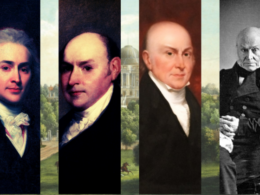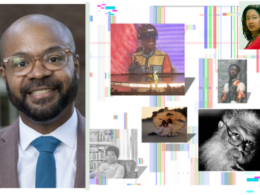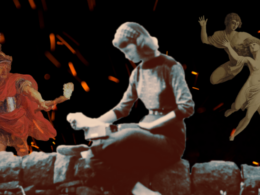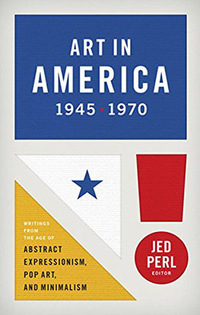
The latest Library of America volume, Art in America 1945–1970, was published earlier this month to glowing reviews in The New York Times, The Wall Street Journal, and elsewhere. Its nearly 150 selections capture the excitement and vitality of the creative explosion during the years following World War II, when the center of the art world shifted from Paris to New York.
We recently interviewed Jed Perl, who edited the anthology. Perl is the art critic for The New Republic and the author of New Art City: Manhattan at Mid-Century, Magicians and Charlatans: Essays on Art and Culture, and other books.
LOA: What’s the aim of this collection—what sorts of pleasures and insights do you hope readers will find?
Perl: With Art in America I want to show how the lives of visual artists in this country have been woven together with the lives of novelists, poets, and intellectuals of all stripes. That’s why it was so important to include—along with the writings of the painters and sculptors themselves and the terrific critics of the time—work by people ranging from the playwright Tennessee Williams to the novelist Mary McCarthy to the political and social critic Dwight Macdonald to the poet Randall Jarrell. One of my gripes about our cultural life in general is that everybody gets Balkanized—all too often poets are only conscious of other poets, novelists of other novelists, painters of other painters. I’ve always liked the idea of cultural cross-fertilization. As an art critic I’ve certainly learned a lot from critics of other art forms. And part of what’s so fascinating about the years just after the war is that the world of art and literature and culture was smaller, almost a village or a neighborhood—so that there was more communication across disciplines and media.
LOA: Why a book of writing about art? What’s the connection between writing/writers and art/artists in this period?
Perl: The connection between the visual and literary arts is a very ancient one—it goes back to the Latin phrase, from Horace, “ut pictura poesis.” Over the centuries the phrase has meant different things to different people—but basically it makes an analogy between what can happen in painting and poetry. Words can paint pictures and pictures can tell stories. Poets of the postwar years like John Ashbery and James Schuyler and Frank O’Hara were acutely aware of this. But more generally, I think there’s something exhilarating about seeing how words can explicate pictures—and the great variety of ways that words can be used to explain the work of an artist like Pollock or de Kooning, ranging from Clement Greenberg’s muscular formalist approach to Harold Rosenberg’s and Meyer Schapiro’s focus on the imaginative freedom of the artist.
LOA: Why the focus on this particular twenty-five-year period?
Perl: The quarter century after World War II was the time when American artists first took the world stage. The story goes from the moment right after the war when the Abstract Expressionists—who had struggled in obscurity during the Depression—were beginning to be widely known to the period in the late 1960s when American art was going global. There are many ways to tell this story. You can see how America’s economic success after the war fueled the success of American art. But you can also argue that in becoming more and more global and less and less local, American art risked losing some of its vigor and individuality. There are some pieces in Art in America—John Bernard Myers’s wonderful “Junkdump Fair Surveyed” and Thomas B. Hess’s “The Battle of Paris”—that begin to explore some of the troublesome aspects of American art’s success story.
LOA: What parallels/contrasts would you draw with the art world today?
Perl: Today’s art world is awash in a kind of money that was unknown fifty years ago. It is hard to remember that although Pollock and de Kooning were famous in the 1950s, they were not making an extraordinary amount of money. I think that many of the kinds of seriousness and playfulness that we encounter in the writing in Art in America are still alive in the studios of artists today—but more and more of the contemporary artists I know feel oppressed by the global art world, which has become a behemoth that casts a very long shadow over the lives of working artists. The publicity machines that keep Koons and Hirst and Murakami afloat take up much too much oxygen. And the frenzy in the art fairs and the auction houses has a pace that has nothing to do with the life of art—which is the life of the imagination. I don’t mean to romanticize the 1950s and 1960s; every period has its particular challenges. But there was a modesty about the art world back then—despite all the swaggering egos—that encouraged deep thought and deep feeling.
LOA: How did you decide which images to include?
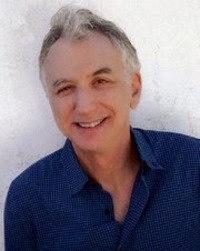
Perl: I wanted Art in America to capture the wonderful heterogeneity of the years after World War II. So the images were selected to support this vision of a time when artists were working in many different ways—representationally and abstractly, with a ripe painterly brush or a cooler, maybe more Olympian, approach. People often imagine that pluralism in the arts is a new idea—a postmodern idea. Part of what I wanted to show with Art in America is that at any given time there are a wide range of different kinds of approaches being pursued. Art is intensely personal. Art is nothing if it’s not personal. We talk about period styles, and of course there may be some truth to such talk. But within a period style, each artist develops a personal style. Finally, it is because no two people are alike that no two artistic expressions can be alike.
LOA: Which piece or writer do you think readers will find most surprising?
Perl: I think most people who open Art in America are going to find some old friends (Greenberg, Rosenberg, O’Hara) mingling with writings that will surprise them—like the funny little poems that Dwight Ripley devoted to the art world in the 1950s, which I treasure for their gossipy charm, their buoyancy, their esprit.
LOA: What’s the most interesting discovery you made in the course of putting the volume together?
Perl: The letter about Pop Art by the wonderfully independent San Francisco artist Jess was a terrific discovery. So far as I know, it’s never been published. A friend of mine, the critic Michael Duncan in Los Angeles, suggested including it. Jess was as interested in pop culture allusions as the Pop Artists, but he wanted to give those allusions a magic and a mystery that he obviously didn’t see in much of the work that was emerging in New York in the 1960s.
LOA: Do you have a favorite piece?
Perl: One favorite piece? I can’t say I do. I like different pieces for different reasons. There will always be a special place in my heart for the writings of Edwin Denby and Fairfield Porter, which are simultaneously mystifying and exacting. Fielding Dawson’s “Emotional Memoir of Franz Kline” has a wonderful romantic atmosphere. And I’m especially pleased that I’ve been able to include the work of Sidney Tillim, whose spirited and now virtually forgotten criticism catches so much of the polemical excitement of the 1960s.
